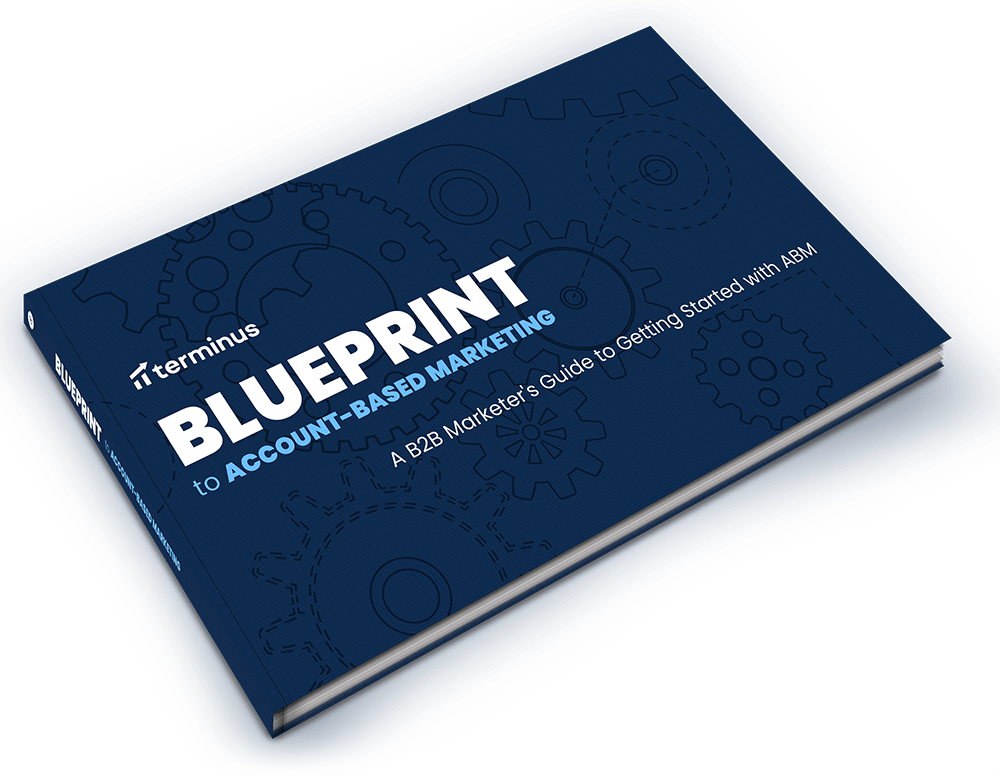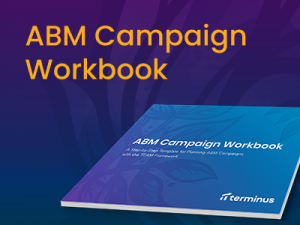
The Terminus Blueprint to Account-Based Marketing

B2B Marketing Channels Workbook
Access it here
A Field Guide to Intent Data for Your B2B Marketing Channels
Check it out
An Actionable Guide to Using the Right B2B Marketing Channels
DownloadB2B Marketing Channels
What is B2B marketing? Before we discuss B2B marketing channels, we should discuss a basic B2B marketing definition. B2B marketing is marketing that occurs business to business, such as SaaS software being sold directly to enterprise customers. What is B2C marketing? It’s marketing that’s business to consumers, such as traditional retail sales. Today, B2B digital marketing is quite big; digital marketing makes it possible to connect with businesses all over the world. But that’s also highly dependent on marketing channels, so let’s also look at the B2B channel marketing definition.
A “channel” is the medium by which a marketer connects with their prospects, such as: physical media, social media, and paid ads. A single digital marketing campaign in the B2B arena might use Twitter, LinkedIn, Facebook, email newsletters, blog posts, and more. Each channel has to be able to work in congruence with the other channels, creating a cohesive and consolidated campaign. It’s important to understand the differences between each channel as well.
Different B2B marketing channels need to be approached differently, but the general B2B and B2C marketing definition will remain the same.
Some channels like LinkedIn do best when content is published and individual people are reached out to. LinkedIn is also a great place to collect information regarding different companies; you can see who is in what position at the company and who is responsible for buying. This is why LinkedIn is often scraped for business information. Twitter, on the other hand, needs to be curated; people need to be able to share posts as well as posting information on their own.
Altogether, this creates a lot of opportunities to connect with people. But it also means that the entirety of the campaign has to be managed through a consolidated center. Often, this is a suite that’s designed for campaign management.
B2B Channel Strategy
When starting or developing your own B2B channel strategy, you can first look at a B2B marketing plan example. Keep in mind that your audience matters. B2B marketing examples India will differ from B2B marketing examples for the US market. Furthermore, B2B marketing examples 2020 will change from B2B marketing examples 2021. And B2B business examples will be different from B2B consumer examples and so forth.
Still, B2B marketing examples and B2C marketing examples are critically important for those trying to develop their own strategies. By looking at B2B marketing campaign examples, you can see what works and doesn’t work in your industry. Likewise, B2C marketing ideas can help inspire you to develop ideas of your own. The best B2B marketing campaigns 2020 will give you information on not only what did work but what you might not want to try.
It’s best to look at studies, reports, guides, and campaigns that relate directly to your industry and your organization’s size. The closer the sample organizations are to your own organization, the more likely it will be to be applicable to your business. Keep in mind the audience and scale of the company, as you don’t want to invest in strategies that won’t resonate with your company’s clients.
Of course, examples, samples, and guides are only going to do so much for you. Most companies are going to need to start their strategies and then invest into developing those strategies in the future. As they continue to progress, they will start to narrow down the strategies that will work best for them. While it is a process, it’s a rewarding one.
B2B Acquisition Channels
Once an organization has guides to follow, it’s time for them to actually develop their B2B marketing strategies or B2C marketing strategies.
Strategies are how the organization actually goes from A to B. You can look at B2B acquisition channels as the pathways that you use to get to where you go. B2B marketing strategies 2020 and 2021 can be used to determine which channels you should use and how. B2B marketing strategies examples show you what works and what doesn’t for other companies, but only experimenting and implementing your marketing strategy will tell you what works and what doesn’t for you.
A basic B2B marketing strategy definition: a B2B marketing strategy framework outlines what the organization is going to do to meet its desired goals. Within the strategy may be other strategies; a B2B marketing strategies PDF could include both a B2B website strategy and B2B email campaign strategy. B2C marketing strategies 2019 will differ significantly from B2B marketing strategies and that has to be kept in mind. Likewise, B2C marketing strategies on social media are different from B2B strategies on the same. A B2C marketing strategies PDF is less likely to be useful to an organization.
There are many innovative B2B marketing strategies that different companies (such as startups) might be interested in using. Even established enterprises may be interested in innovation as far as strategies go, but untested campaigns are also riskier. Most organizations will use a blend of established strategies and out-of-the-box strategies to try to extend their brand identity and connect with their customers. The initial strategy does form the roadmap, but experimentation is what’s really going to form the organization’s core strategy outlook in the future.
B2B Channels
During the formation of a strategy, companies need to look at the B2B channels that are right for them. Marketing channels examples include email, social media, and even phone connections. A B2B distribution channel example can be looked at to form a basis for the B2B distribution channels a company might be interested in; for instance, a company with retail goods might go through Amazon or eBay. Distribution channels aren’t entirely separate from B2B marketing channels 2020; there are many B2B wholesale platforms (like Alibaba) that are one in the same.
B2C marketing channels, B2C sales channels, and the B2B channel structure should all be a part of the organization’s overall strategy. The strategy has to include both what channels are going to be used and how marketing will be used on these channels. In this way, the organization will be able to fine-tune its delivery of content. The organization has to have direction for its efforts.
Further, the organization will need to know its metrics for success. If one of its B2B channels is Twitter, how much engagement would it consider successful? Is it looking at users? Engagement? This will tell the organization whether its strategies are working or whether its strategies need to be changed. Analysis will be necessary as the organization moves ahead to determine which B2B channels, both sales and communication-wise, are being most effective for their products, services, and overall brand identity.
Different companies and industries will perform more or less strongly on different B2B channels. As an example, SaaS companies perform very well on LinkedIn. Startups often find that Instagram and Twitter work well for them, because of the direct connection with their audience. High value products and services often perform better through physical mailers and emails, because they have a more personal touch. And, of course, customization and account-based marketing has become key to many B2B sales.
B2B Sales Channels
Why is it that the best B2B sales channels seem to change year to year? Why are B2B marketing trends 2020 not the same as B2B marketing trends 2021?
The market moves fast. Digitization and globalization has made it move even faster. Organizations can change vendors very quickly. They are constantly being inundated with new options for products. Because of that, your B2B content marketing trends 2020 are going to differ from 2021. Everything moves very quickly.
If you look up the top 7 B2B marketing trends to embrace in 2020, you’ll see a lot about taking advantage of the quarantine, COVID, and work-from-home. Moving into 2021, some of these trends persist, but many of them are changing. People are going back into the office, the quarantine is fading, and the overall influence of these global, momentous events has waned.
Because of this, it’s important for organizations to stay on top of current trends and to constantly adjust their strategies. If your strategies aren’t being continually adjusted, it’s going to be difficult (if not impossible) to keep up with the competition. The more current a strategy is, the more effective it will be. Again, examples and case studies can show how the market is changing.
Types of Sales Channels
How do companies choose between all of the different types of sales channels? It really depends. When developing their strategies, there’s usually a B2B marketing mix. And it depends on the B2B marketing models as well, and the B2C marketing tools. The best B2B marketing strategies are going to be the ones that an organization develops over time. But that all starts with examples, models, and strategies gleaned from the internet.
There are many types of sales channels out there. But it also depends on whether the organization is able to manage these channels. And that often depends on the organization’s sales platforms.
A sales platform is what actually manages the sales channels for the organization, often consolidating the channel information as well as the organization’s communications with future prospects and existing customers. The sales platform will show sales and marketing teams exactly how much engagement they’re getting through each of the sales channels, as well as where they could improve, and where they may be experiencing issues or bottlenecks.
Platforms such as Terminus can be used to connect to individuals not only through your website but also through email and other venues. Through Terminus, analysis can be done regarding which types of sales channels are performing better, and which channels may not be worth the investment of time and money. Sales platforms and marketing suites are able to save organizations money by providing them with the data and analysis they need.
Many organizations will choose a platform first, based on their needs. From there, they can choose the sales channels that work best for them.